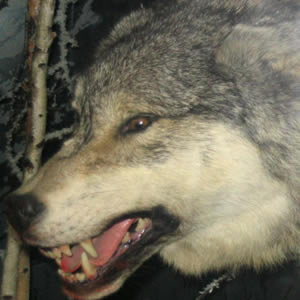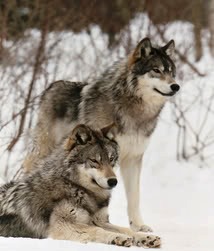|
Canidae is the biological family of carnivorous and omnivorous mammals that includes wolves, foxes, jackals, coyotes, and domestic dogs. In Alaska there are five types of canines. They include the domestic dog, arctic fox, red fox, coyote, and gray wolf.
Wolves in Southeast Alaska tend to be darker and somewhat smaller than those in northern parts of the state. The pelt color of Alaska wolves ranges from black to nearly white, with every shade of gray and tan in between. Gray or black wolves are most common, and the relative abundance of each color phase varies over time and from place to place. Gray wolves have very dense and fluffy winter fur, with short underfur and long, coarse guard hairs. Most of the underfur and some of the guard hairs are shed in the spring and grow back in the autumn period. The longest hairs occur on the back, particularly on the front quarters and neck. Especially long hairs are found on the shoulders, and almost form a crest on the upper part of the neck. The hairs on the cheeks are elongated and form tufts. The ears are covered in short hairs which strongly project from the fur.
Most adult male wolves in Interior Alaska weigh from 85
to 115 pounds (38.6-52.3), but they occasionally reach
145 pounds (65.3 kg). Females average 10 to 15 pounds
(2-5 kg) lighter than males and rarely weigh more than
110 pounds (50 kg). Wolves reach adult size by about 1
year of age. The wolf occurs throughout mainland Alaska,
on Unimak Island in the Aleutians, and on all of the
major islands in Southeast except Admiralty, Baranof,
and Chichagof. This range includes about 85 percent of
Alaska's 586,000 square-mile area. The highest densities
occur in Southeast Alaska, where Sitka black-tailed deer
serve as the major food source for wolves. Wolf
densities are lowest in the coastal portions of western
and northern Alaska.
Wolves are social animals and usually live in packs that include parents and pups of the year. The average pack size is six or seven animals, and pack members often include some yearlings and other adults. Packs of 20 to 30 wolves sometimes occur, and these larger packs may have two or three litters of pups from more than one female. The social order in the pack is characterized by a separate dominance hierarchy among females and males. In most areas wolf packs tend to remain within a territory used almost exclusively by pack members, with only occasional overlap in the ranges of neighboring packs.
Wolves are carnivores, and in most of mainland Alaska moose and/or caribou are their primary food, with Dall sheep, squirrels, snowshoe hares, beaver, and occasionally birds and fish as supplements in the diet. Where salmon are available, they are an important seasonal food source for wolves in some areas, and are especially important to pups, The rate at which wolves kill large mammals varies with prey availability and environmental conditions. A pack may kill a deer or moose every few days during the winter. At other times, they may go for several days with almost no food. Since wolves are opportunistic, young, old, or debilitated animals are preyed upon more heavily than healthy middle-age animals. Under some circumstances, however, such as when snow is unusually deep or prey is scarce, even animals in their prime may be vulnerable to wolves.
In Southeast Alaska, Sitka black-tailed deer, mountain goats, and beaver are the most important sources of food. Research indicates that salmon are important seasonally where they are available, especially to young wolves. During summer, small mammals including voles, lemmings and ground squirrels are taken. Wolves also scavenge, and coastal wolves will beach comb.
Alaska is home to an estimated 7,000 to 11,000 wolves. Wolves have never been threatened or endangered in Alaska. The food habits of the wolf often bring it into conflict with humans who in many parts of the world are also hunters of big game animals. Although the wolf has coexisted with big game animals for thousands of years, under some conditions the impact of predation contributes to local scarcities of game which arouse some people's concern. In most non-coastal systems with moose and caribou, wolves and bears together maintain game populations below levels at which their food supply would be damaged.
Wolves in Alaska are managed as both a big game animal and a furbearer; they are hunted and also trapped. Each year, hunters and trappers harvest about 1,300 wolves in the state, with up to an additional 200 animals or so taken annually via intensive management (predator control) programs. As with all furs, the prices paid for wolf pelts vary from year to year. All harvested wolves must be taken to an Alaska Department of Fish and Game or representative office for “sealing,” a process in which the hide is examined, recorded and a tag or seal is affixed.
|







